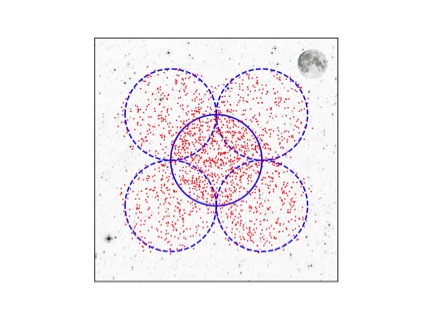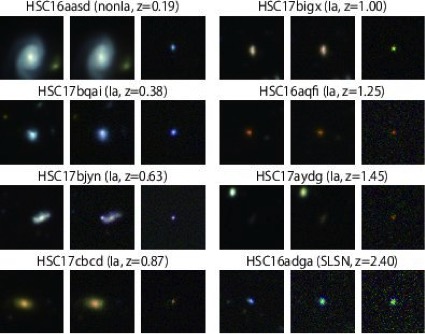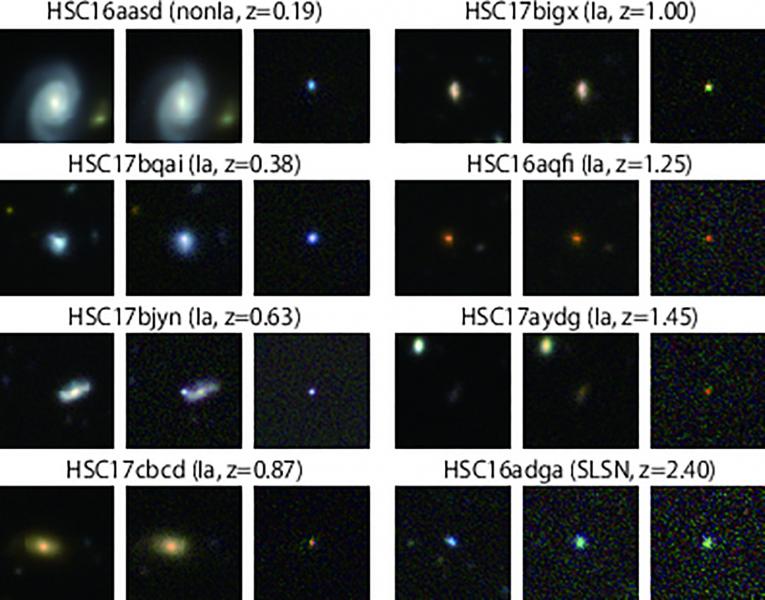May 30, 2019
Kavli Institute for the Physics and Mathematics of the Universe (Kavli IPMU)
School of Science, The University of Tokyo
Graduate School of Science and Faculty of Science, Tohoku University
Konan University
National Astronomical Observatory of Japan (NAOJ)
Kyoto University
 By combining one of the world’s most powerful digital cameras and a telescope capable of capturing a wider shot of the night sky compared to other big telescopes, a team of researchers from Japan have been able to identify about 1800 new supernovae, including 58 Type Ia supernovae 8 billion light years away, reports a new study released online on 30 May.
By combining one of the world’s most powerful digital cameras and a telescope capable of capturing a wider shot of the night sky compared to other big telescopes, a team of researchers from Japan have been able to identify about 1800 new supernovae, including 58 Type Ia supernovae 8 billion light years away, reports a new study released online on 30 May.
A supernova is the name given to an exploding star that has reached the end of its life. The star often becomes as bright as its host galaxy, shining one billion times brighter than the Sun for anytime between a month to six months before dimming down. Supernova classed as Type Ia are useful because their constant maximum brightness allows researchers to calculate how far the star is from Earth. This is particularly useful for researchers who want to measure the expansion of the Universe.
In recent years, researchers began reporting a new type of supernovae five to ten times brighter than Type Ia supernovae. Named Super Luminous Supernovae, many have been trying to learn more about these stars. Their unusual brightness enables researchers to spot stars in the farthest parts of the Universe usually too faint to observe. Since distant Universe means the early Universe, studying this kind of star could reveal characteristics about the first, massive stars created after the Big Bang.
But supernovae are rare events, and there are only a handful of telescopes in the world capable of capturing sharp images of distant stars. In order to maximize the chances of observing a supernova, a team led by Kavli Institute for the Physics and Mathematics of the Universe (Kavli IPMU) Professor Naoki Yasuda, and researchers from Tohoku University, Konan University, the National Astronomical Observatory of Japan, School of Science, the University of Tokyo, and Kyoto University, used the Subaru Telescope.
This telescope is capable of generating shape stellar images, and the Hyper Suprime-Cam, an 870 mega-pixel digital camera attached at its top, captures a very wide area of the night sky in one shot.
By taking repeated images of the same area of night sky over a six month period, the researchers could identify new supernovae by looking for stars that suddenly appeared brighter before gradually fading out.
As a result, the team identified 5 super luminous supernovae, and about 400 Type Ia supernovae. Fifty-eight of these Type Ia supernovae were located more than 8 billion light years away from Earth. In comparison, it took researchers using the Hubble Space Telescope about 10 years to discover a total of 50 supernovae located more than 8 billion light years away from Earth.
“The Subaru Telescope and Hyper Suprime-Cam have already helped researchers create a 3D map of dark matter, and observation of primordial black holes, but now this result proves that this instrument has a very high capability finding supernovae very, very far away from Earth. I want to thank all of my collaborators for their time and effort, and look forward to analyzing our data to see what kind of picture of the Universe it holds,” said Yasuda.
The next step will be to use the data to calculate a more accurate expansion of the Universe, and to study how dark energy has changed over time.
Details of the study were published by the Publications of the Astronomical Society of Japan.

Images
All images can be downloaded from here
https://web.ipmu.jp/press/201905-HSC-SSP/
All images of supernovae discovered in this paper can be viewed on this website (Credit: M. Koike)
https://web.ipmu.jp/press/201905-HSC-SSP/HSC_SNimages/
Paper details
Journal: Publications of the Astronomical Society of Japan
Title: The Hyper Suprime-Cam SSP Transient Survey in COSMOS: Overview
Authors: Naoki Yasuda (1), Masaomi Tanaka (2,1), Nozomu Tominaga (3,1), Ji-an Jiang (4), Takashi J. Moriya (5), Tomoki Morokuma (4,1), Nao Suzuki (1), Ichiro Takahashi (1,6), Masaki S. Yamaguchi (3), Keiichi Maeda (7,1), Masao Sako (8), Shiro Ikeda (9,1), Akisato Kimura (10), Mikio Morii (9), Naonori Ueda (10), Naoki Yoshida (11,1,6), Chien-Hsiu Lee (12), Sherry H. Suyu (13,14), Yutaka Komiyama (5,15), Nicolas Regnault (16), David Rubin (17,18)
Author affiliations:
1. Kavli Institute for the Physics and Mathematics of the Universe (WPI), The University of Tokyo Institutes for Advanced Study, The University of Tokyo, 5-1-5 Kashiwanoha, Kashiwa, Chiba 277-8583, Japan
2. Astronomical Institute, Tohoku University, Aoba, Sendai 980-8578, Japan
3. Department of Physics, Faculty of Science and Engineering, Konan University, 8-9-1 Okamoto, Kobe, Hyogo 658-8501, Japan
4. Institute of Astronomy, Graduate School of Science, The University of Tokyo, 2-21-1 Osawa, Mitaka, Tokyo 181-0015, Japan
5. National Astronomical Observatory of Japan, National Institutes of Natural Sciences, 2-21-1 Osawa, Mitaka, Tokyo 181-8588, Japan
6. CREST, JST, 4-1-8 Honcho, Kawaguchi, Saitama 332-0012, Japan
7. Department of Astronomy, Kyoto University, Kitashirakawa-Oiwake-cho, Sakyo-ku, Kyoto 606-8502, Japan
8. Department of Physics and Astronomy, University of Pennsylvania, Philadelphia, PA 19104, USA
9. Research Center for Statistical Machine Learning, The Institute of Statistical Mathematics, 10-3 Midori-cho, Tachikawa, Tokyo 190-8562, Japan
10. NTT Communication Science Laboratories, 2-4 Hikaridai, Seika-cho, Keihanna Science City, Kyoto 619-0237, Japan
11. Department of Physics, Graduate School of Science, The University of Tokyo, 7-3-1 Hongo, Bunkyo-ku, Tokyo 113-0033, Japan
12. Subaru Telescope, National Astronomical Observatory of Japan, 650 N Aohoku Pl., Hilo, HI 96720, USA
13. Max-Planck-Institut für Astrophysik, Karl-Schwarzschild-Str. 1, 85748 Garching, Germany
14. Physik-Department, Technische Universität München, James-Franck-Straße 1, 85748 Garching, Germany
15. Graduate University for Advanced Studies (SOKENDAI), 2-21-1 Osawa, Mitaka, Tokyo 181-8588, Japan
16. Sorbonne Université, Université Paris Diderot, CNRS/IN2P3, Laboratoire de Physique Nucléaire et de Hautes Energies, LPNHE, 4 Place Jussieu, 75252 Paris, France
17. Physics Division, Lawrence Berkeley National Laboratory, 1 Cyclotron Road, Berkeley, CA 94720, USA
18. Space Telescope Science Institute, 3700 San Martin Drive, Baltimore, MD 21218, USA
DOI: 10.1093/pasj/psz050 (Published May 30, 2019)
Paper abstract (Publications of the Astronomical Society of Japan)
Research contact
Naoki Yasuda
Professor
Kavli Institute for the Physics and Mathematics of the Universe
The University of Tokyo
TEL: +81-04-7136-6548
E-mail: naoki.yasuda_at_ipmu.jp
* please change _at_ to @
Media contact
Motoko Kakubayashi
Press officer
Kavli Institute for the Physics and Mathematics of the Universe
University of Tokyo
TEL:+81-04-7136-5980
E-mail:press_at_ipmu.jp
* please change _at_ to @







